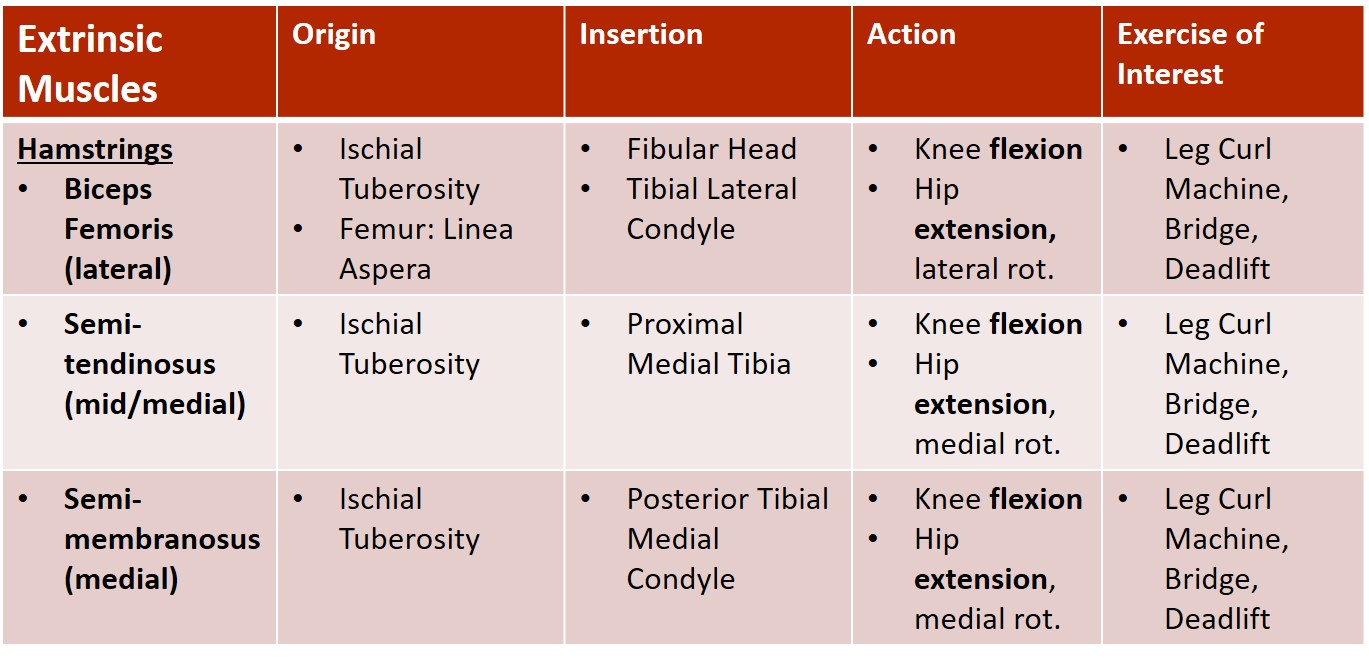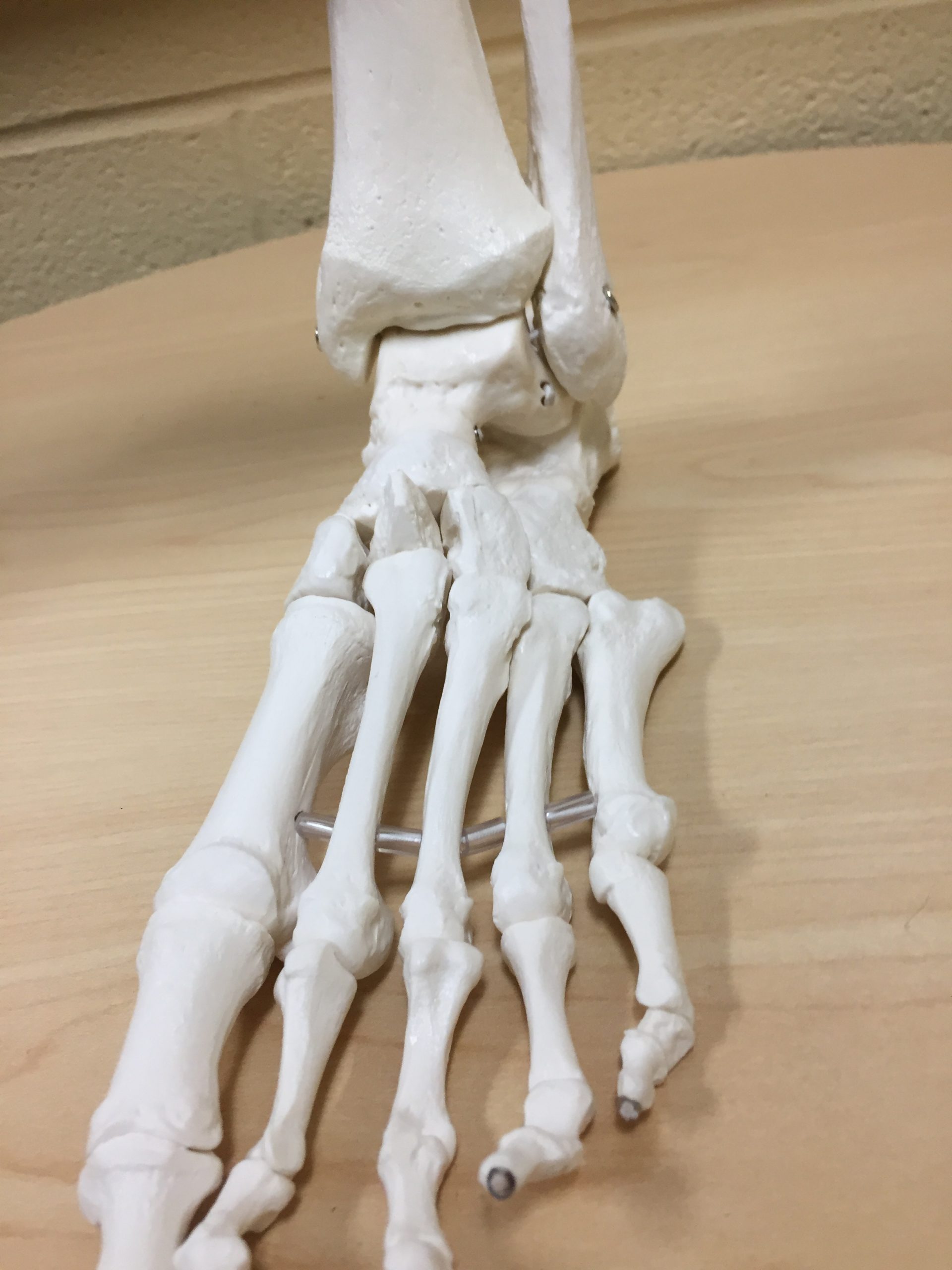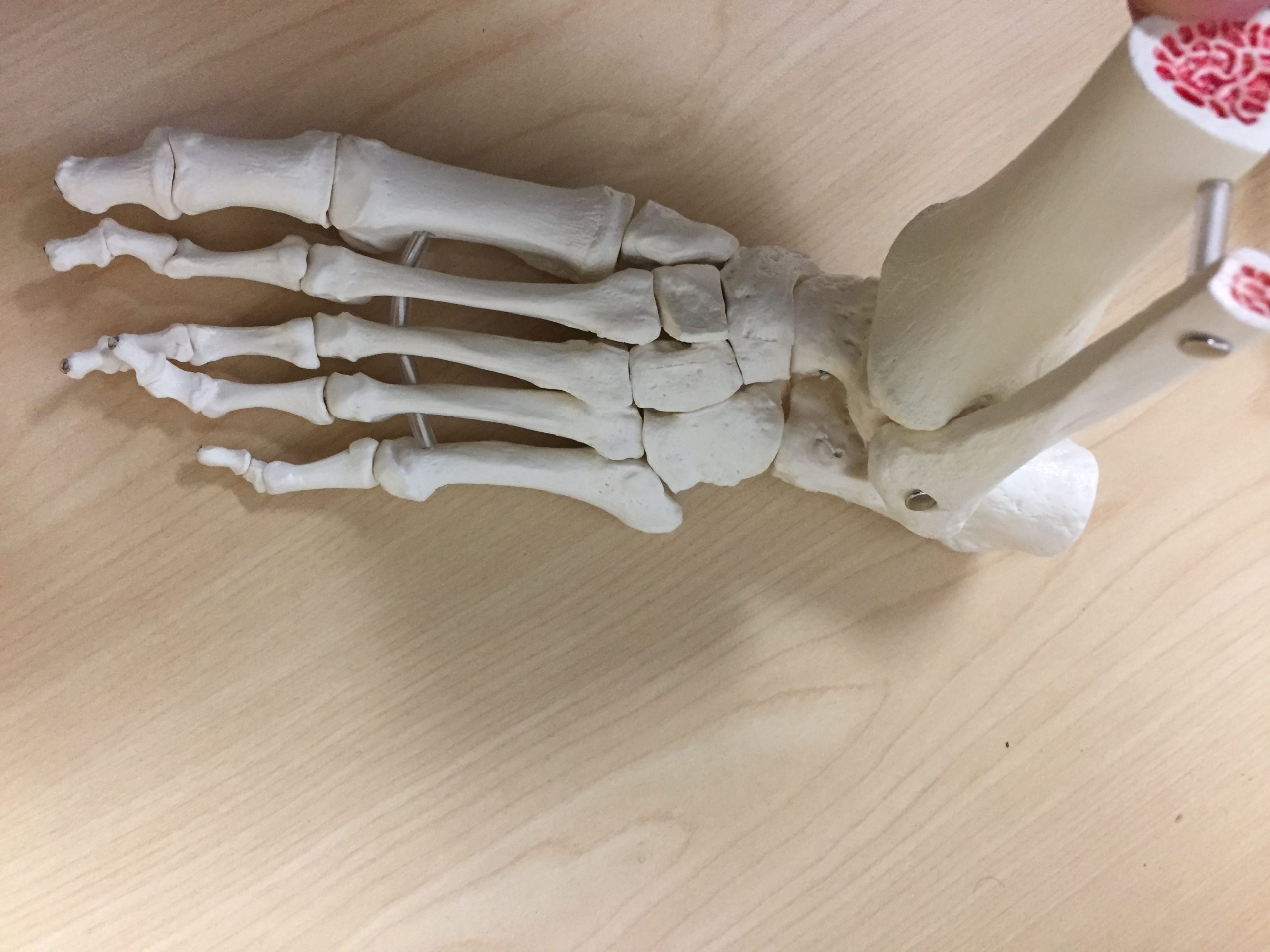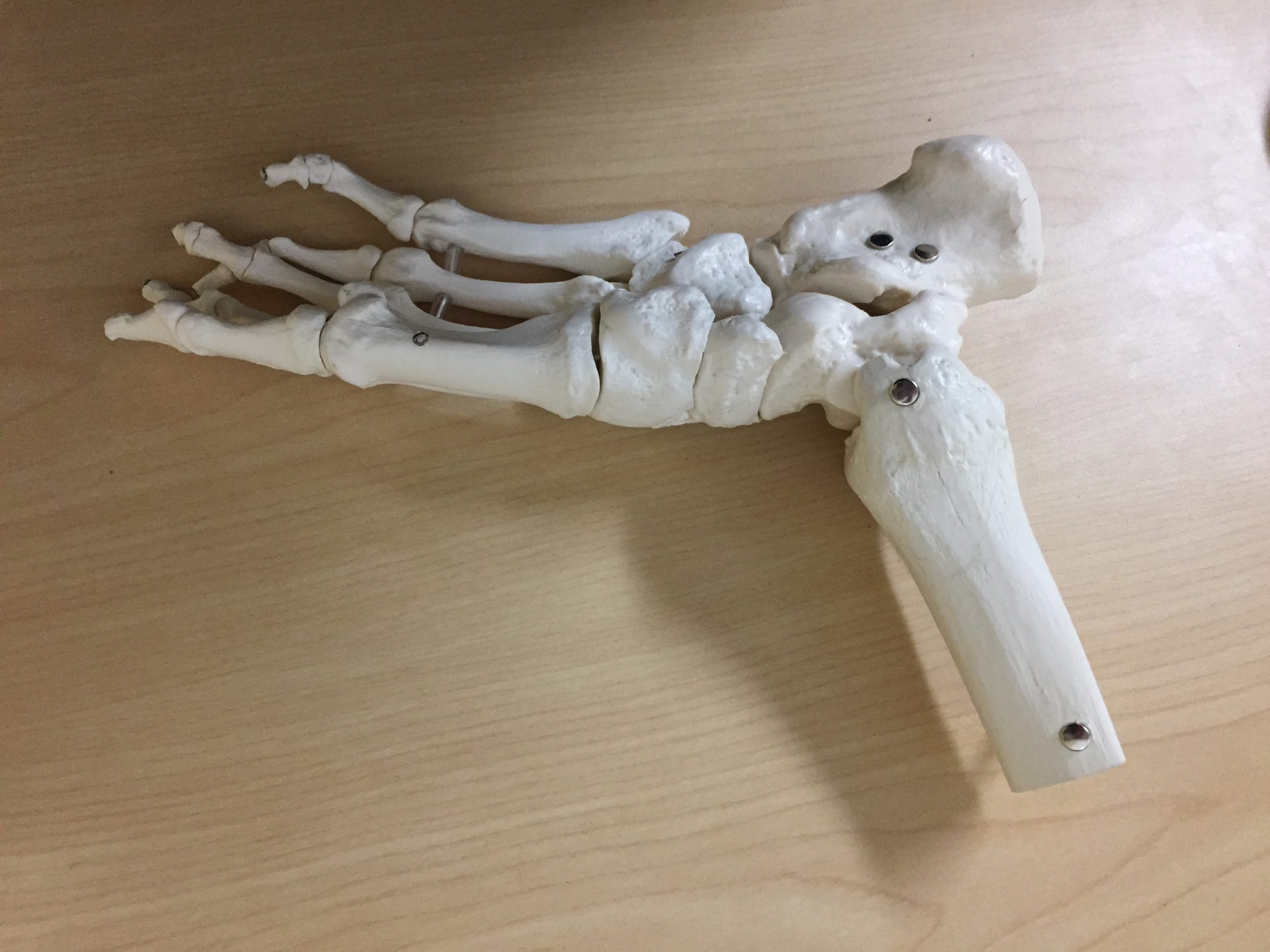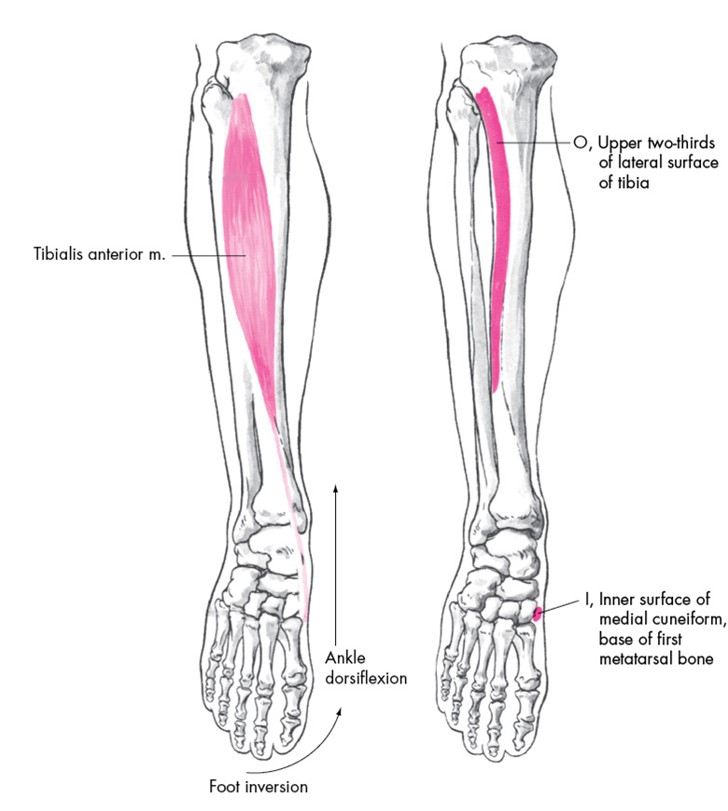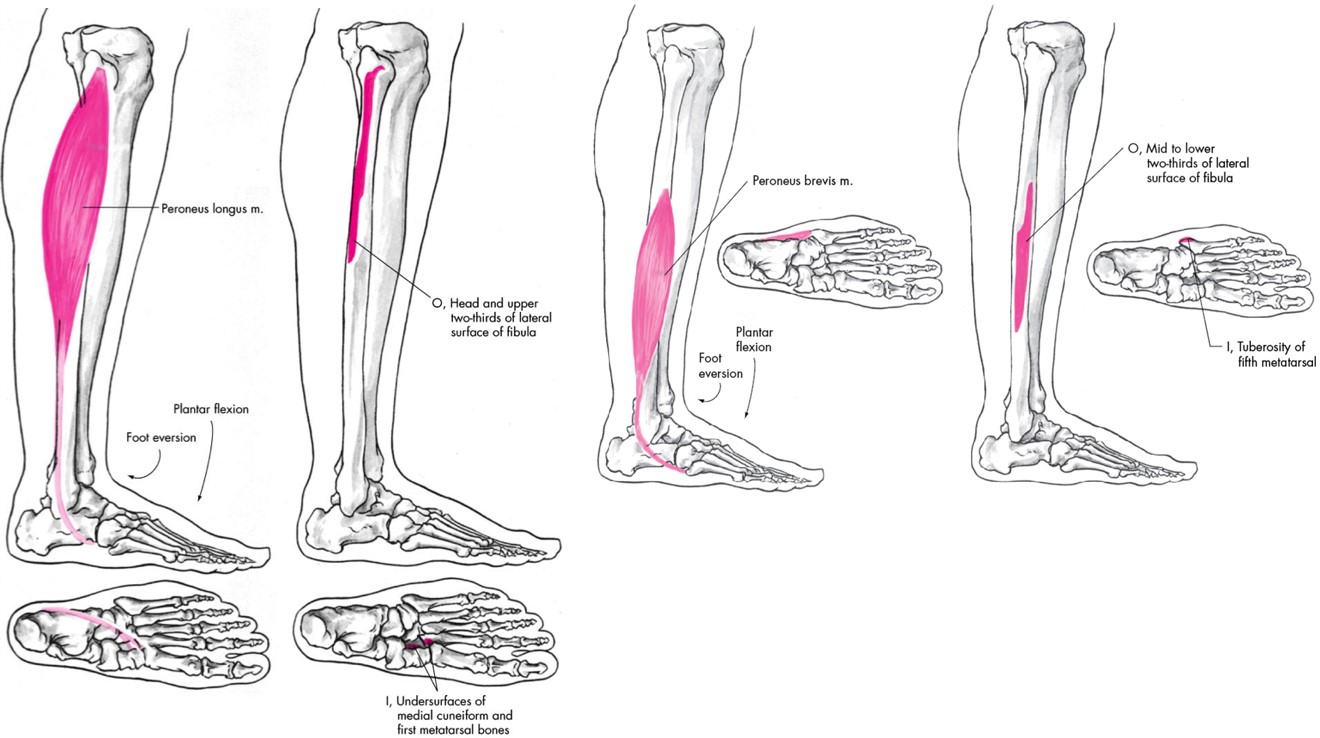Task Category: Knowledge
Foot and Ankle Plantar Flexor Muscles
Key Bony Markings
Discuss the key bony markings related to the Soleus and Gastrocnemius Muscles (posterior femoral condyles, fibular head, interosseous membrane, and calcaneus).

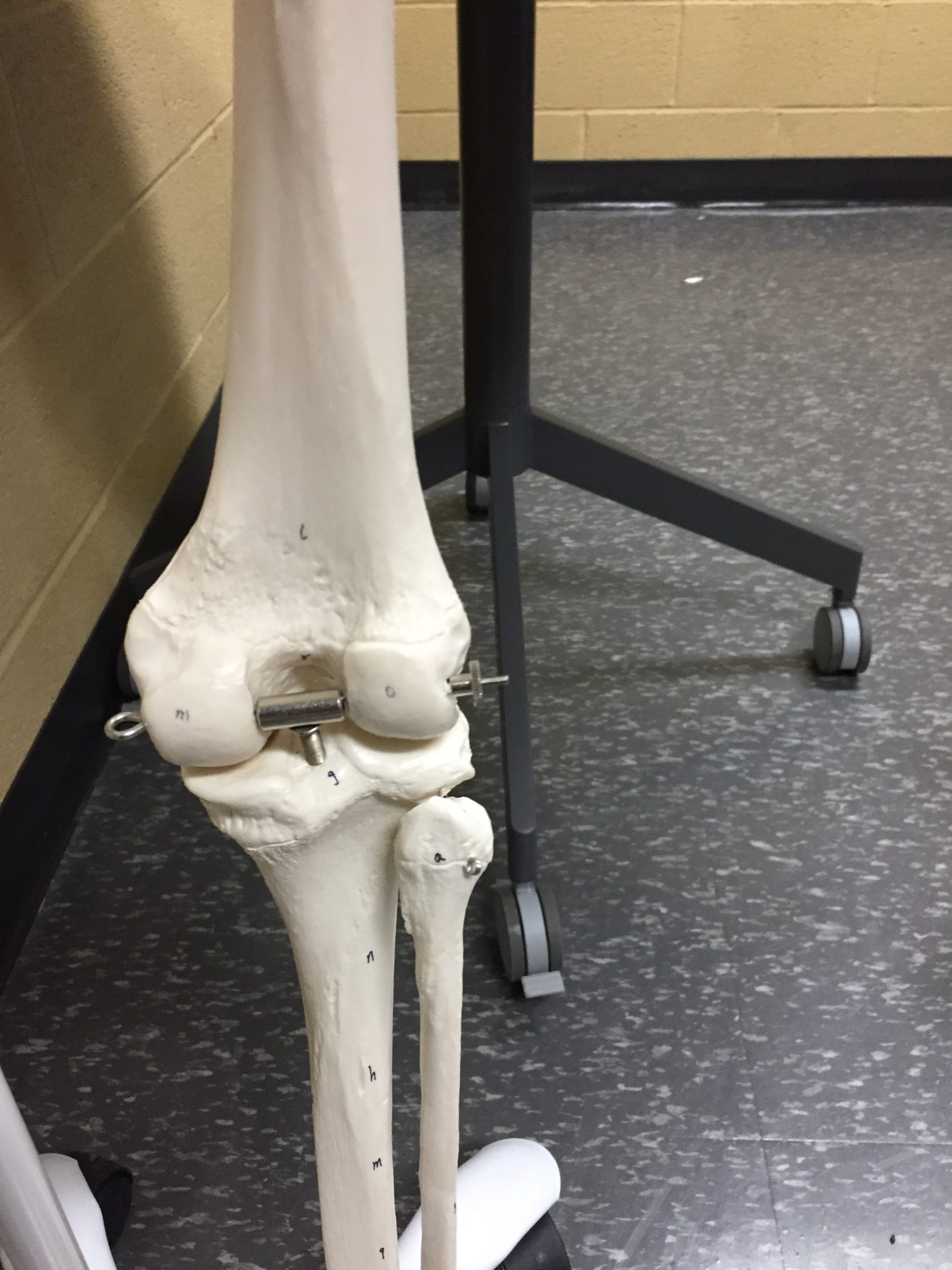
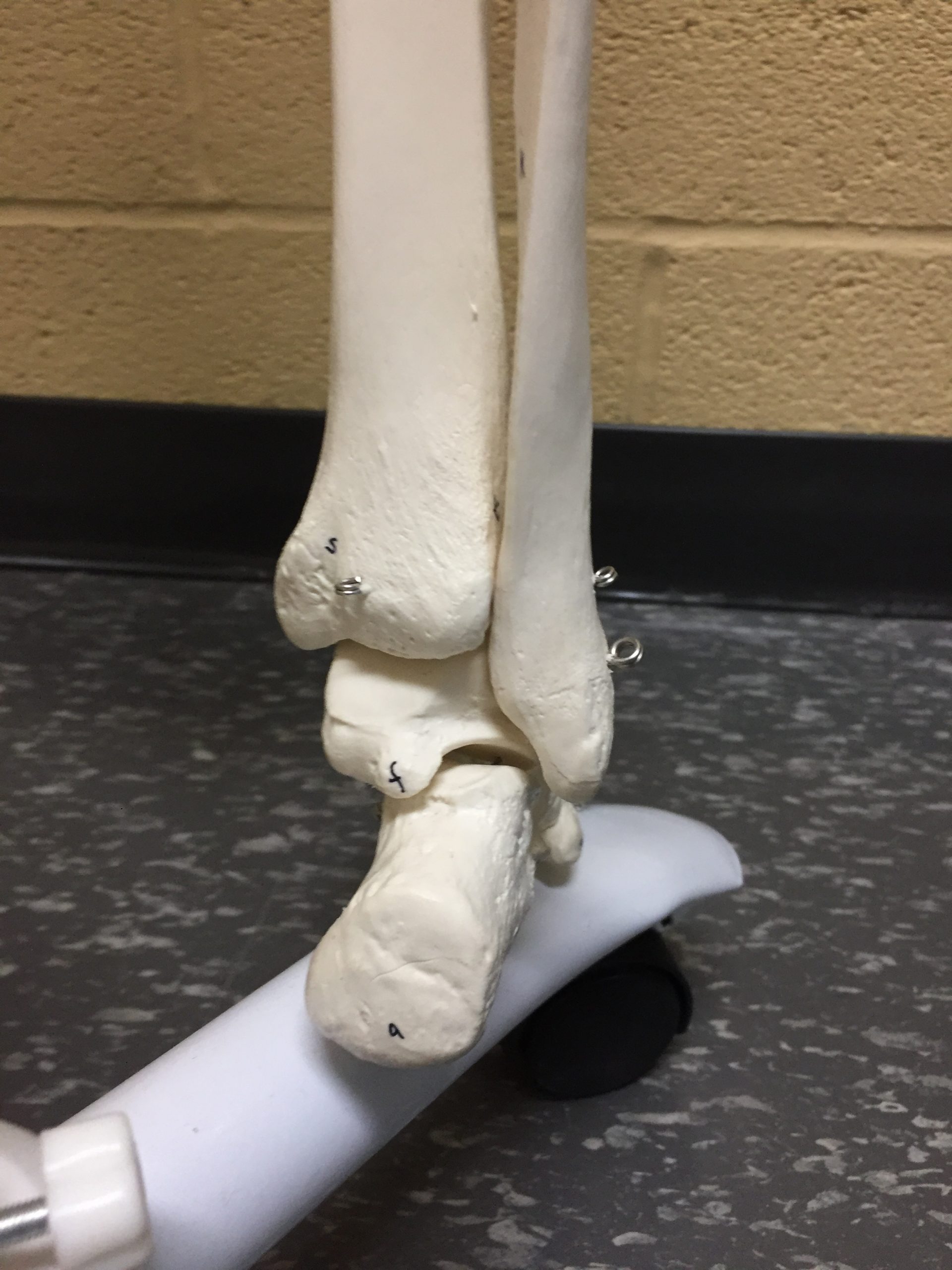
The Plantar Flexors
Discuss the O, I, and A of the following muscle.
- Gastrocnemius
- Soleus
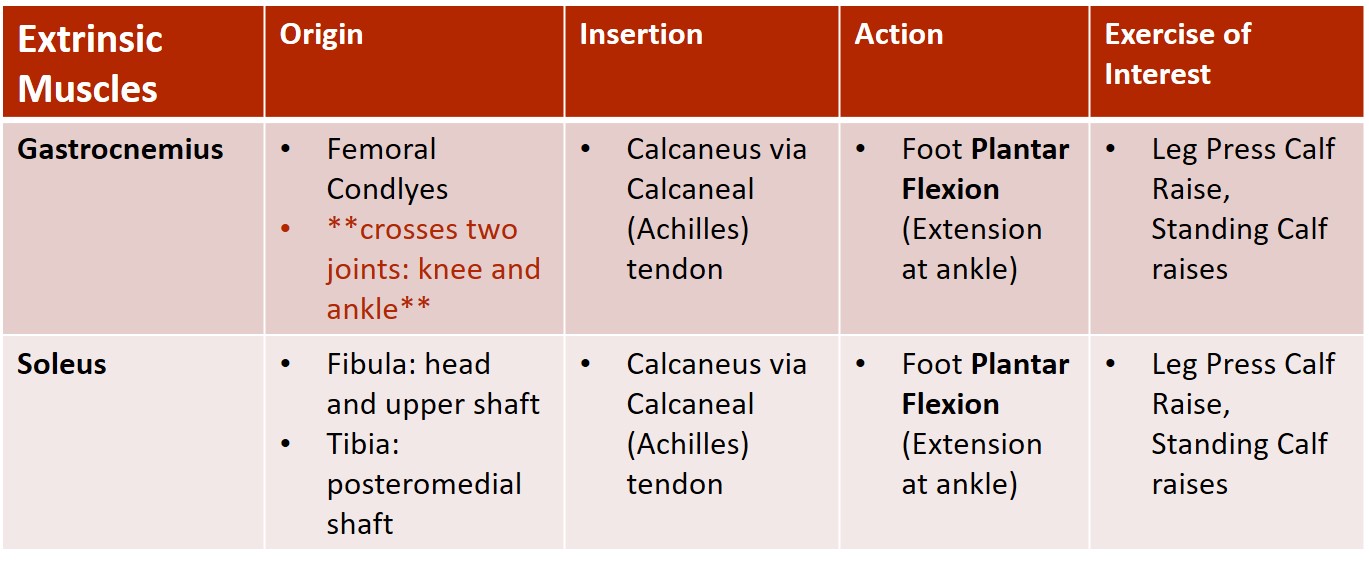
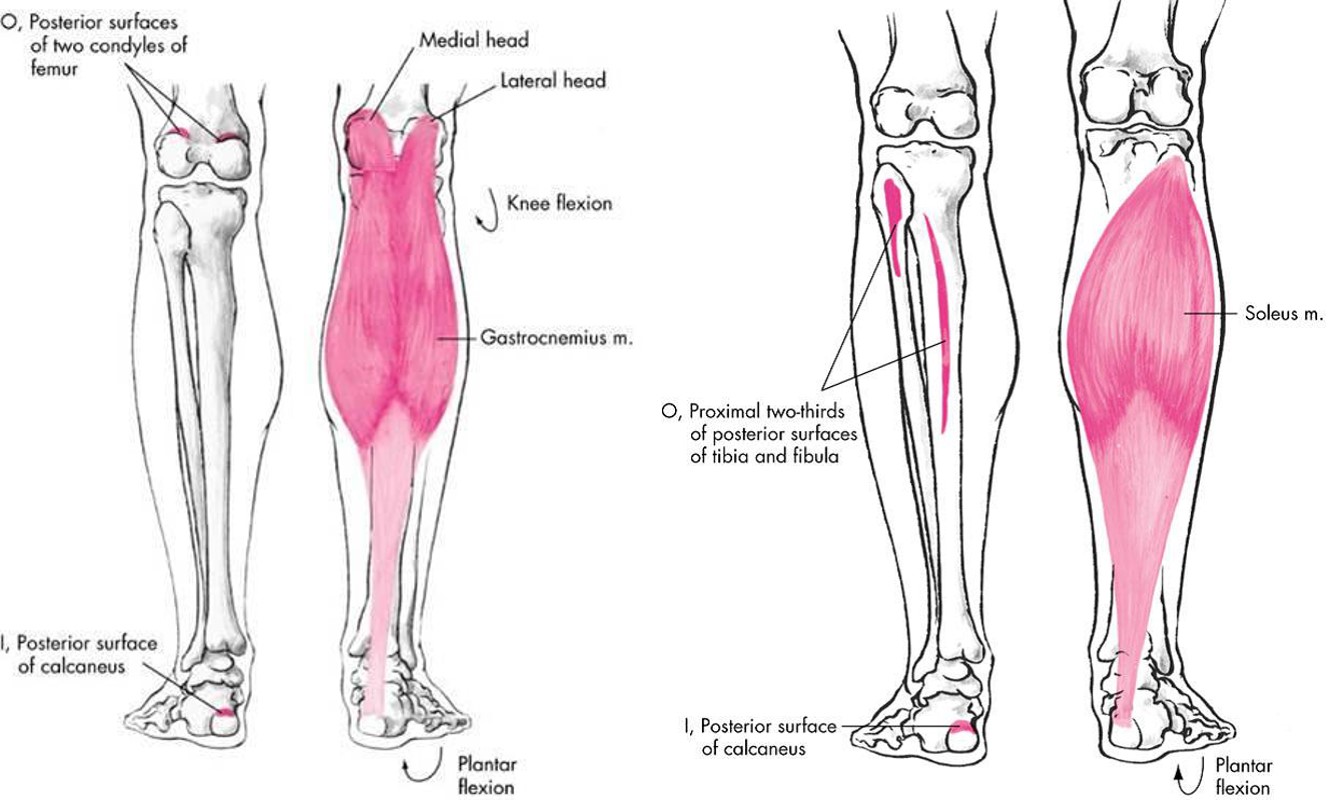
Review and practice the Hinge and Rotate exercises
Familiarize yourself with various HINGE and ROTATE exercises (with and without instability), experience the exercises, and recognize when you would coach these exercises (with whom and when in training).
General form and cue reminders:
- stiff neutral spine
- level pelvis
- maximal hip flexion-extension
- minimal knee flexion-extension
- near vertical shin angle
- TRX Hinge
- TRX Hip Press (Hip Bridge)
- TRX Hamstring Curl Press to Hip Press
- TRX Pike
- TRX Windmill (note: exercise involves both rotate and hinge)
- Kettlebell Windmill (note: exercise involves both rotate and hinge)
- Bosu Hip Bridge
- Stability Ball Pike
- Single Leg Deadlift
Rotational strength is trained for striking power. These exercises involve core stability with hip mobility. As with all exercise done to increase power, these exercises are done in an unstable environment.
General form and cue reminders:
- maintain core stability
- maintain neutral posture
- generate power through the core using mobility in the hips, shoulders, and thoracic spine
After reviewing and practising these exercises, mark this task as complete, and move to the final task of completing a full (Hinge or Rotate) peer review exam practice.
Review Lab Exam Comptencies
The following exercise pairings will be possibilities for your lab exam.
- Instruct client to stand with feet approximately shoulder width apart, toes pointed slightly out. | 1
- Discuss the importance of maintaining as erect a torso as possible (neutral spine) throughout the movement. | 1
- Instruct client to keep knees aligned with toes (knees don't collapse in) | 1
- Discuss target ROM (squat until knees are bent below 90 degrees) | 1
- Cue client to keep weight back (e.g.: weight over ankles or more towards heels than toes) | 1
- Client completes at least 10 reps. | 1
- Screen pain/discomfort during squat. | 1
- Offer client the option to use a mat | 1
- Explain and cue engaging the core, keeping pelvis stable | 1
- Instruct and verify client can fully extend a single leg (while maintaining neutral spine) | 1
- Instruct and verify client can fully extend a single arm (while maintaining neutral spine) | 1
- Instruct and verify client can fully extend the opposing arm-leg, hold for ~2 seconds | 1
- Perform 6-8 reps per side | 1
- Screen pain/discomfort during bird-dog | 1
- Explain a stretch appropriate for a novice client that targets the muscles trained in the squat. | 1
- Determine a stance length/width that should allow the client to be balanced. | 1
- Mention the importance of maintaining as erect a torso as possible (neutral spine) throughout the movement. | 1
- Explain target range-of-motion (i.e. knees form a 90˚angle at the bottom of the movement.) | 1
- Cue client to push off through the heel of the lead leg | 1
- Complete 8-10 reps per leg | 1
- Screen pain/discomfort during split squat | 1
- Offer client the option to use a mat | 1
- Have client assume a prone position (lying face down) on the floor with the legs fully extended and the toes pointed down to the floor. | 1
- Cue your client to keep the core engaged (torso should remain in a straight line; neutral spine) | 1
- Have client place their hands on the floor, palms down, ~ 1 to 3 inches wider than shoulder-width apart with the elbows pointed outward. | 1
- Explain the impact of moving hands closer in/further away from shoulder-width | 1
- Have client push (i.e. fully extend the elbows), then lower the body by allowing the elbows to flex to a 90° angle (or a position where the chest is hovering 1-2″ above the ground) | 1
- Complete at least 10 reps | 1
- Screen pain/discomfort during push-up | 1
- Explain a stretch appropriate for a novice client that targets the muscles trained in the split squat. | 1
- Offer client option to use a mat | 1
- Have client lie on their back, feet planted on the floor. Arms at sides for balance | 1
- Explain that movement involves client thrusting hips forward to full extension by pushing off heels and contracting glutes | 1
- Watch client demonstrate movement, helping client achieve full extension, if necessary | 1
- Complete at least 10 reps | 1
- Screen pain/discomfort during bridge | 1
- Demonstrate/teach progression to 1-leg bridge | 1
- Again, offer client the option to use a mat | 1
- Mention the importance of maintaining as erect a torso as possible (neutral spine) throughout the movement | 1
- In a prone position, have client brace against forearms, with elbows positioned under the shoulders, legs fully extended and the toes pointed down to the floor | 1
- Explain and cue engaging the core | 1
- Instruct the client to raise body upward until body is help in a straight line | 1
- Have client attempt to hold position for at least 30 seconds | 1
- Screening of pain/discomfort during plank | 1
- Explain a stretch appropriate for a novice client that targets the muscles used in the hip bridge | 1
- Position a bar in a rack to a height that will allow client to extend arms without lying on the floor | 1
- Using a slightly wider than shoulder width grip (hands pronated), have client hang underneath the bar | 1
- Client’s body should be straight (neutral spine) with heels on the ground with their arms fully extended | 1
- Instruct the client to initiate movement by flexing the elbow, pulling their chest towards the bar. Pause then return to starting position | 1
- Complete at least 10 reps | 1
- Screening pain/discomfort during row | 1
- Offer your client a mat | 1
- Have client lie on their back on the floor with one leg extended straight and flat on the floor, the knee of the opposite leg should be bent and the foot flat | 1
- Explain to client the desired range-of-motion and target muscle activation | 1
- Have client place their hands hands palms down on the floor underneath the natural arch in their lower back | 1
- Have client slowly raise their head and shoulders off the floor without bending the lower back or spine | 1
- Hold this position for 7 to 10 seconds, then lower torso back to mat | 1
- Complete 3-5 repetitions | 1
- Screening pain/discomfort during crunch | 1
- Explain a stretch appropriate for a novice client that targets the muscles used in the row | 1
PHRE 1041 Lab Exam Competencies
The following exercise pairings will be possibilities for your lab exam.
- Instruct client to stand with feet approximately shoulder width apart, toes pointed slightly out. | 1
- Discuss the importance of maintaining as erect a torso as possible (neutral spine) throughout the movement. | 1
- Instruct client to keep knees aligned with toes (knees don't collapse in) | 1
- Discuss target ROM (squat until knees are bent below 90 degrees) | 1
- Cue client to keep weight back (e.g.: weight over ankles or more towards heels than toes) | 1
- Client completes at least 10 reps. | 1
- Screen pain/discomfort during squat. | 1
- Offer client the option to use a mat | 1
- Explain and cue engaging the core, keeping pelvis stable | 1
- Instruct and verify client can fully extend a single leg (while maintaining neutral spine) | 1
- Instruct and verify client can fully extend a single arm (while maintaining neutral spine) | 1
- Instruct and verify client can fully extend the opposing arm-leg, hold for ~2 seconds | 1
- Perform 6-8 reps per side | 1
- Screen pain/discomfort during bird-dog | 1
- Explain a stretch appropriate for a novice client that targets the muscles trained in the squat. | 1
- Determine a stance length/width that should allow the client to be balanced. | 1
- Mention the importance of maintaining as erect a torso as possible (neutral spine) throughout the movement. | 1
- Explain target range-of-motion (i.e. knees form a 90˚angle at the bottom of the movement.) | 1
- Cue client to push off through the heel of the lead leg | 1
- Complete 8-10 reps per leg | 1
- Screen pain/discomfort during split squat | 1
- Offer client the option to use a mat | 1
- Have client assume a prone position (lying face down) on the floor with the legs fully extended and the toes pointed down to the floor. | 1
- Cue your client to keep the core engaged (torso should remain in a straight line; neutral spine) | 1
- Have client place their hands on the floor, palms down, ~ 1 to 3 inches wider than shoulder-width apart with the elbows pointed outward. | 1
- Explain the impact of moving hands closer in/further away from shoulder-width | 1
- Have client push (i.e. fully extend the elbows), then lower the body by allowing the elbows to flex to a 90° angle (or a position where the chest is hovering 1-2″ above the ground) | 1
- Complete at least 10 reps | 1
- Screen pain/discomfort during push-up | 1
- Explain a stretch appropriate for a novice client that targets the muscles trained in the split squat. | 1
- Offer client option to use a mat | 1
- Have client lie on their back, feet planted on the floor. Arms at sides for balance | 1
- Explain that movement involves client thrusting hips forward to full extension by pushing off heels and contracting glutes | 1
- Watch client demonstrate movement, helping client achieve full extension, if necessary | 1
- Complete at least 10 reps | 1
- Screen pain/discomfort during bridge | 1
- Demonstrate/teach progression to 1-leg bridge | 1
- Again, offer client the option to use a mat | 1
- Mention the importance of maintaining as erect a torso as possible (neutral spine) throughout the movement | 1
- In a prone position, have client brace against forearms, with elbows positioned under the shoulders, legs fully extended and the toes pointed down to the floor | 1
- Explain and cue engaging the core | 1
- Instruct the client to raise body upward until body is help in a straight line | 1
- Have client attempt to hold position for at least 30 seconds | 1
- Screening of pain/discomfort during plank | 1
- Explain a stretch appropriate for a novice client that targets the muscles used in the hip bridge | 1
- Position a bar in a rack to a height that will allow client to extend arms without lying on the floor | 1
- Using a slightly wider than shoulder width grip (hands pronated), have client hang underneath the bar | 1
- Client’s body should be straight (neutral spine) with heels on the ground with their arms fully extended | 1
- Instruct the client to initiate movement by flexing the elbow, pulling their chest towards the bar. Pause then return to starting position | 1
- Complete at least 10 reps | 1
- Screening pain/discomfort during row | 1
- Offer your client a mat | 1
- Have client lie on their back on the floor with one leg extended straight and flat on the floor, the knee of the opposite leg should be bent and the foot flat | 1
- Explain to client the desired range-of-motion and target muscle activation | 1
- Have client place their hands hands palms down on the floor underneath the natural arch in their lower back | 1
- Have client slowly raise their head and shoulders off the floor without bending the lower back or spine | 1
- Hold this position for 7 to 10 seconds, then lower torso back to mat | 1
- Complete 3-5 repetitions | 1
- Screening pain/discomfort during crunch | 1
- Explain a stretch appropriate for a novice client that targets the muscles used in the row | 1
Muscled Leg, Hip and Torso Models – Bringing it all Together
Torso Model
Can you identify key structures on a complete model? Practice reviewing key structures on complete models; which gluteal or hamstring muscle is that? Can you see the TFL and ITB
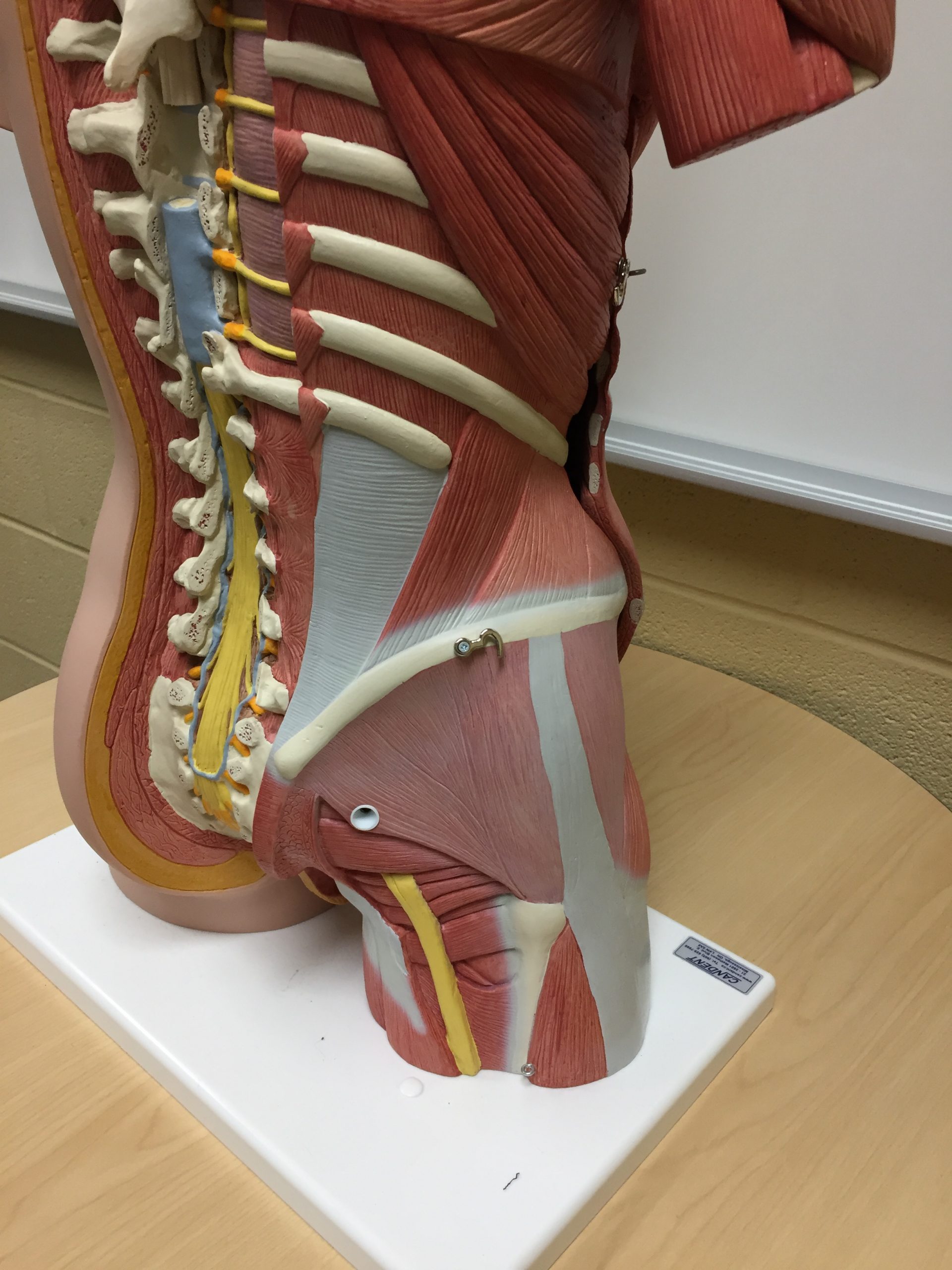
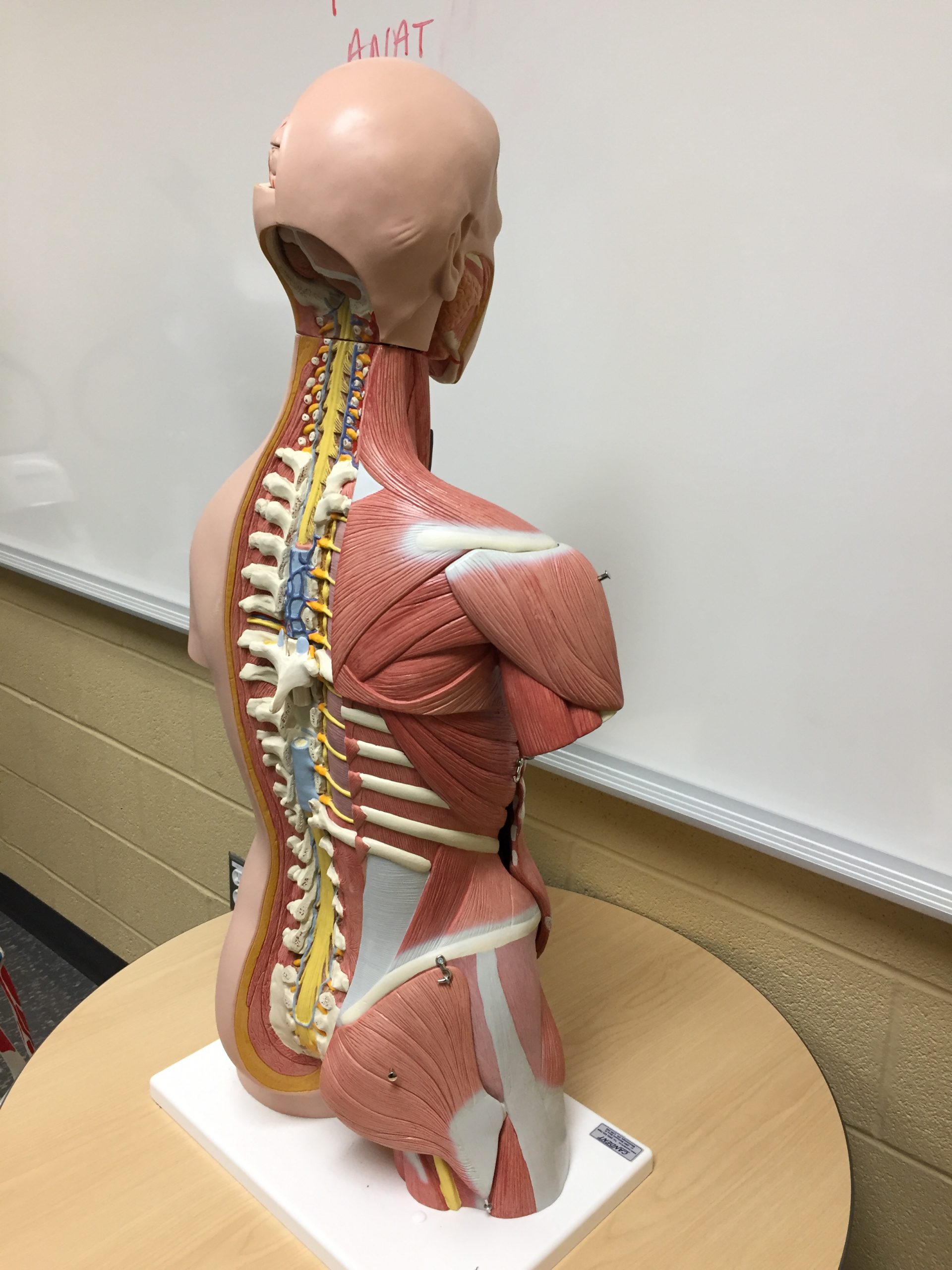
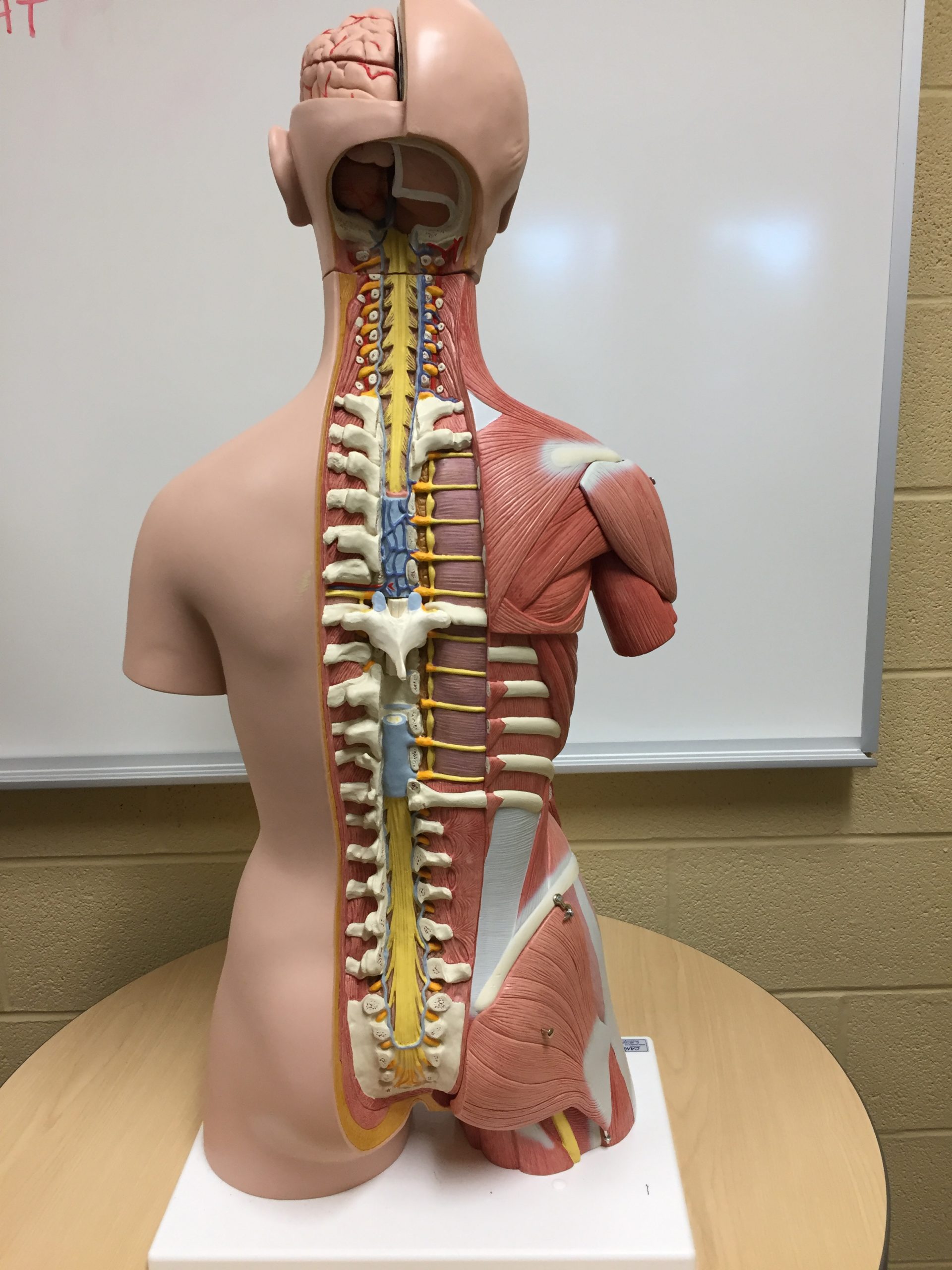
Muscled Leg and Hip
Can you identify key structures on a complete model? Practice reviewing key structures on complete models; which gluteal or hamstring muscle is that? Where is the TFL and ITB?

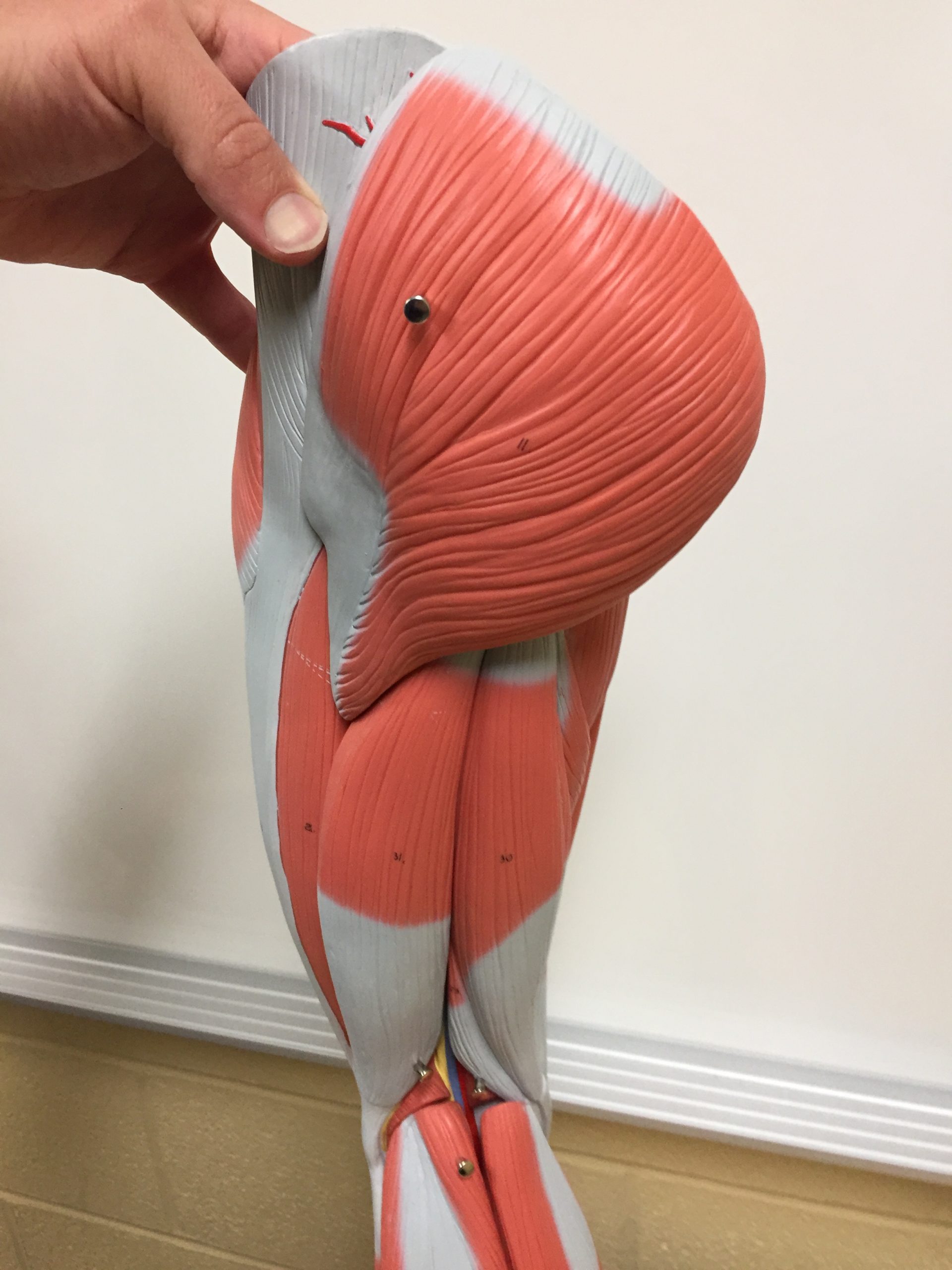
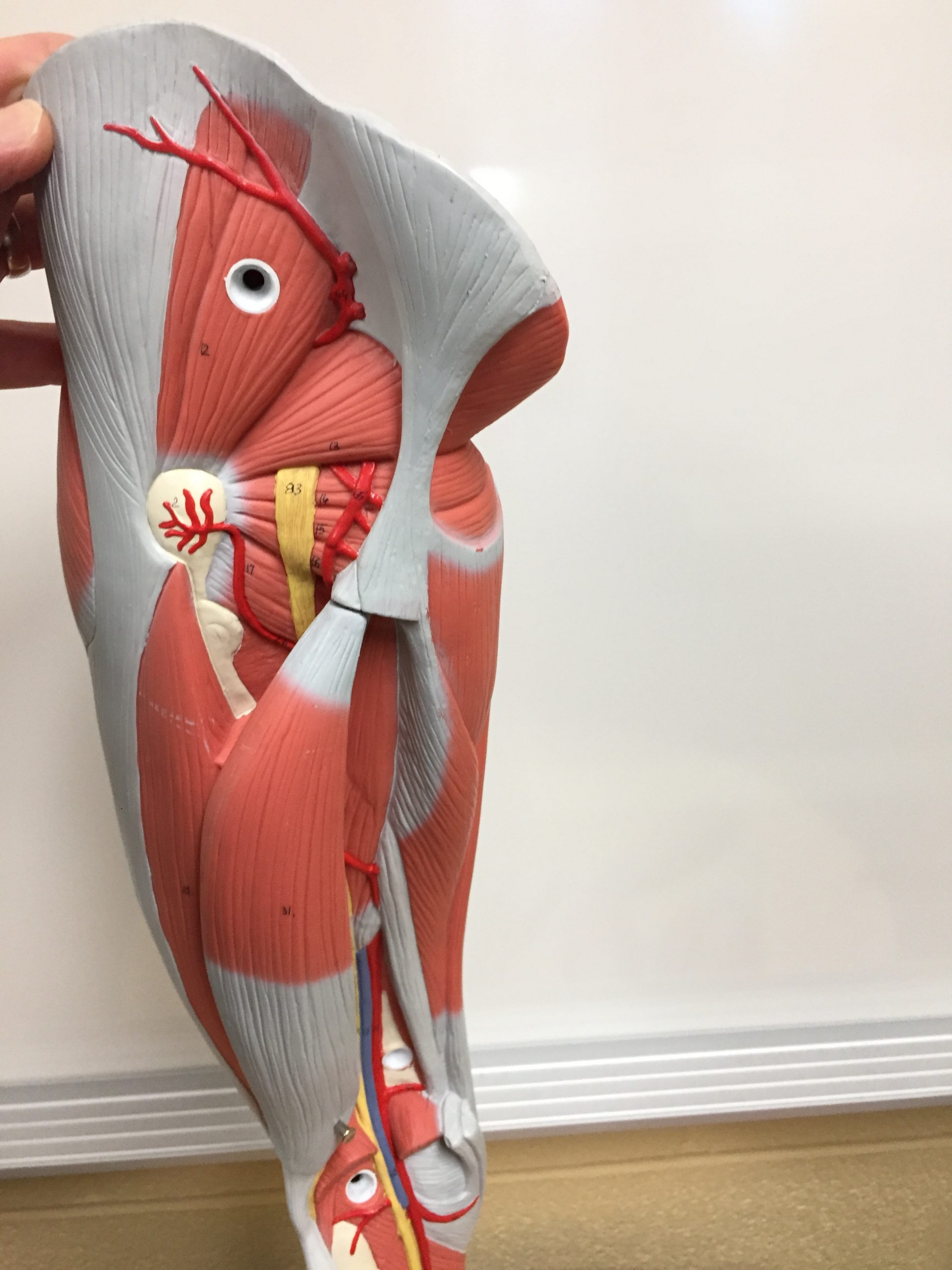
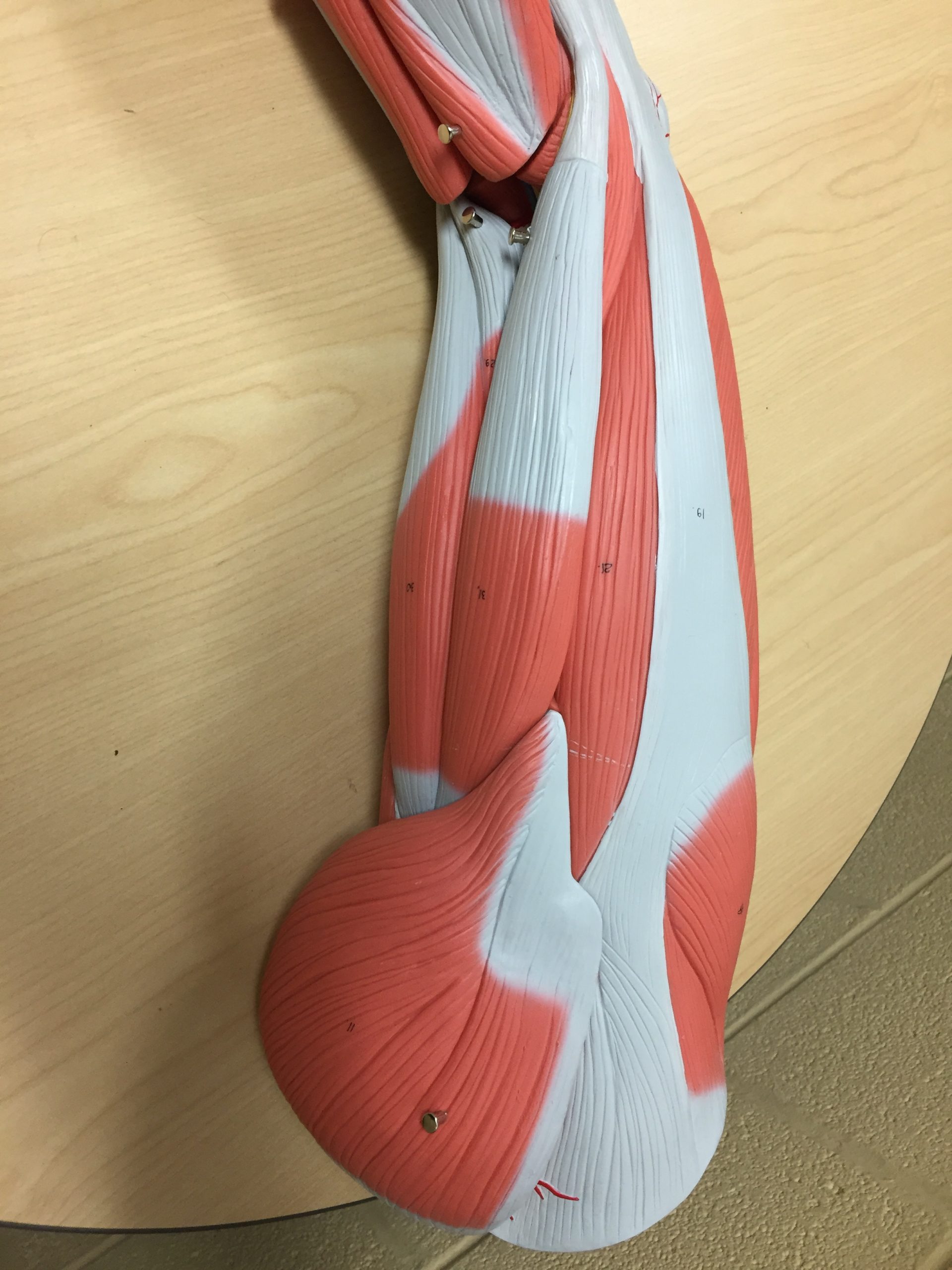
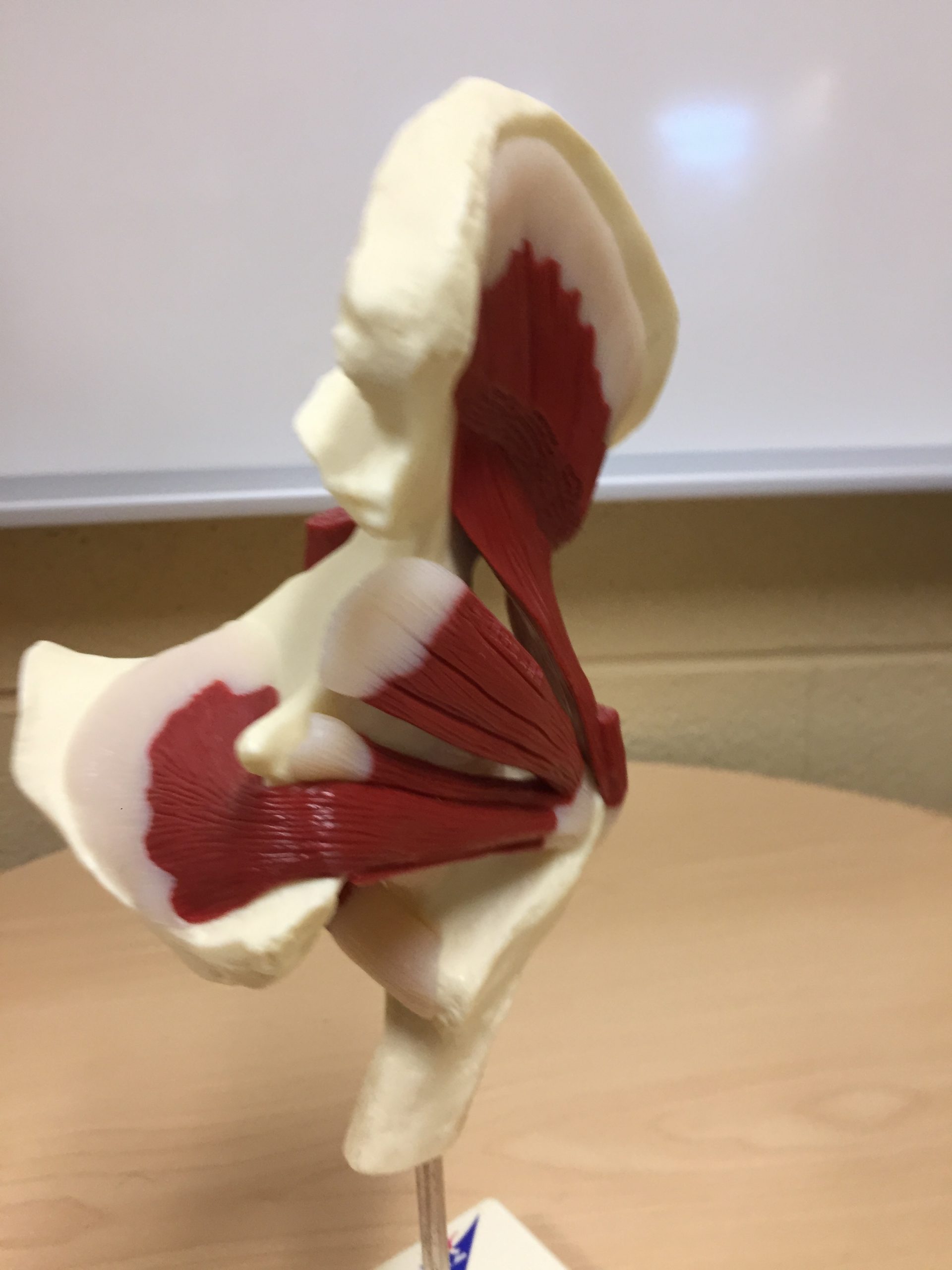
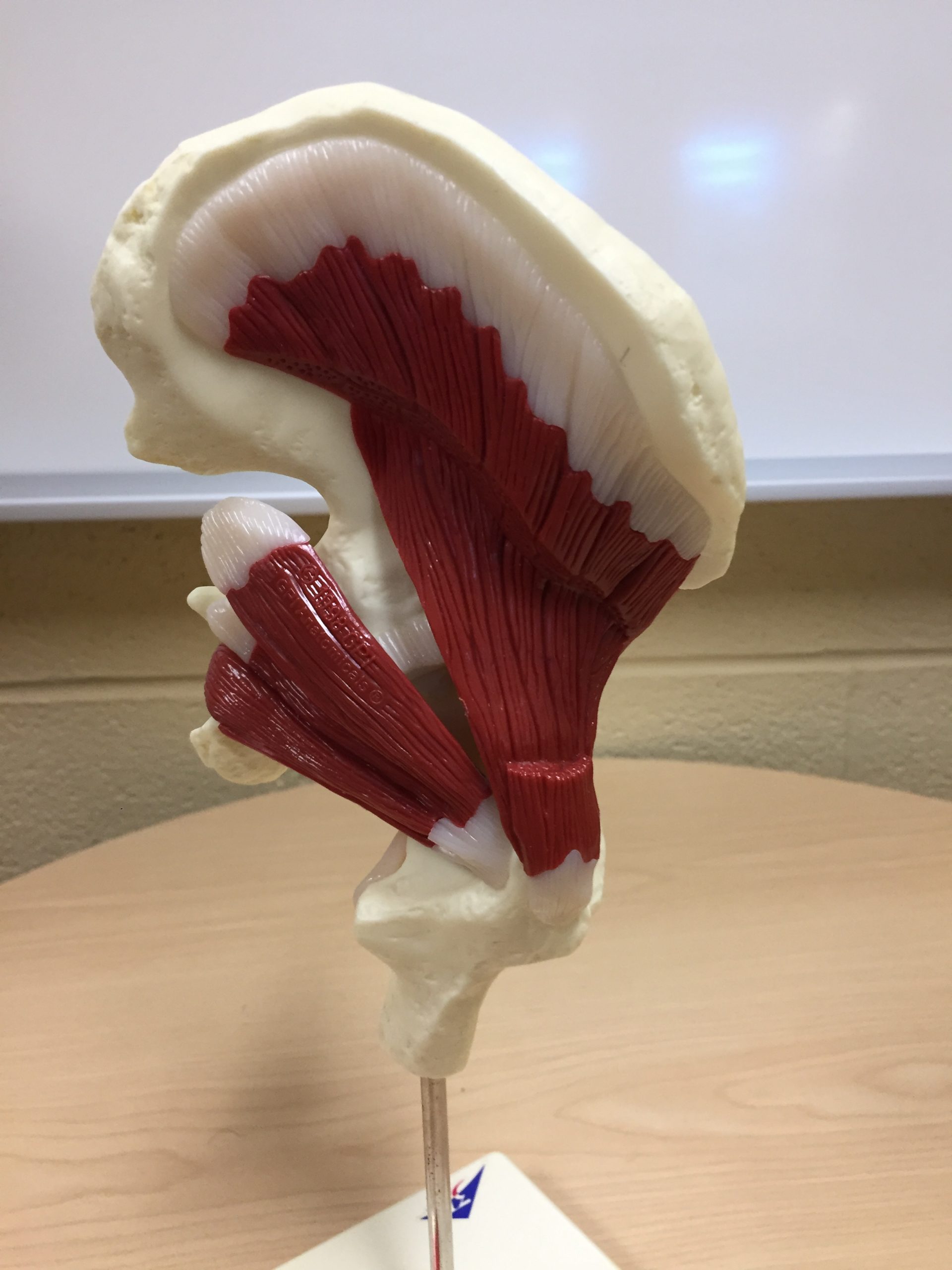
Hip Hinging Related Exercises
Leg Curl
Complete 10 repetitions of the exercise. Imagine origin and insertion of the main muscle(s) involved. Identify the prime mover (agonist), antagonist, and action.
| Movement Pattern: Single-joint | isolation | Target: Hamstrings | Synergist(s): Gastrocnemius | |
| Exercise | 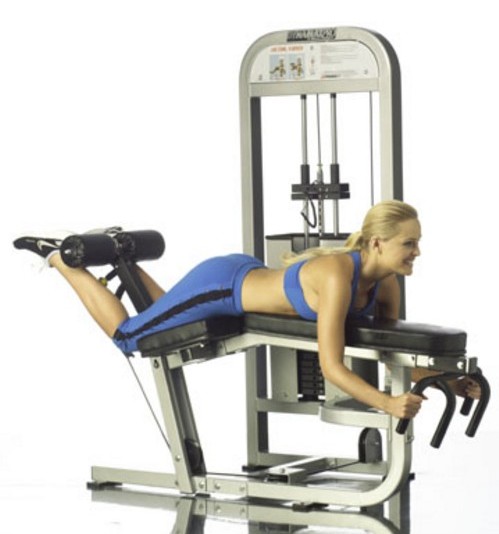 |
||
| Regressions: | Progressions: | Nordic Hamstrings Curl | TRX Hamstring Curl to Hip Press (Bridge) | |
Hip Bridge
Complete 10 repetitions of the exercise. Imagine origin and insertion of the main muscle(s) involved. Identify the prime mover (agonist), one synergist, antagonist, and action.
| Movement Pattern: Hinge | Target: Gluteals | Synergist(s): Hamstrings | |
| Exercise | 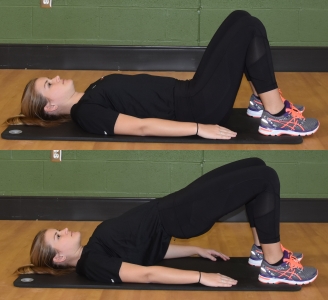 |
||
| Regressions: | Progressions: | Deadlift | Leg Curl | |
| Key Teaching Points | |||
|---|---|---|---|
|
|||
| Common Error(s): | Not engaging core | ||
| Spotting: | |||
Fire Hydrant
Complete 10 repetitions of the exercise. Imagine origin and insertion of the main muscle(s) involved. Identify the prime mover (agonist), two synergists, and action.
| Movement Pattern: Lower Body | Target: Hip Abductors | Synergist(s): IT Band | |
| Exercise | 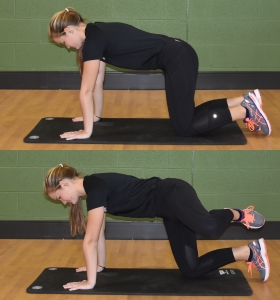 |
||
| Regressions: | Progressions: | ||
| Key Teaching Points | |||
|---|---|---|---|
Perform this slowly for a number of repetitions, and repeat on the other side. |
|||
| Common Error(s): | Not engaging core | ||
| Spotting: | |||
Deadlift
Complete 10 repetitions of the exercise. Imagine origin and insertion of the main muscle(s) involved. Identify the agonist, synergist, stabilizing synergists of the trunk, and action.
| Movement Pattern: Hinge | Target: Gluteals | Synergist(s): Hamstrings, Spinal Erectors | |
| Exercise | 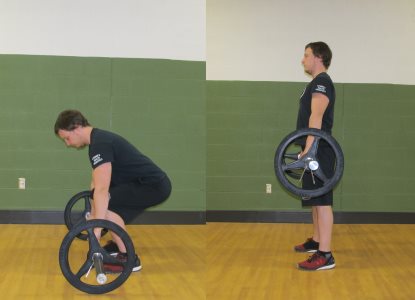 |
||
| Regressions: | Pull Through | Trap Bar Deadlift | Progressions: | Swing |
| Key Teaching Points | |||
|---|---|---|---|
|
Conventional Deadlift
Variations
|
|||
| Common Error(s): | Arching the upper back | Rounded shoulders | ||
| Spotting: | |||
Gluteals and TFL Muscles
Key Bony Markings
Discuss the key bony markings related to Gluteal and Hip flexor muscles; pelvis (Iliac Crest, ASIS, Anterior, Posterior and Inferior Gluteal Lines, SI Joint, Sacrum, Coccyx), femur (Gluteal tuberosity and femoral condyles), tibia condyles and fibular head.

Gluteal Muscles
Discuss the O, I, and A of the following core muscles.
Gluteus Maximus, Minimis, and Medius
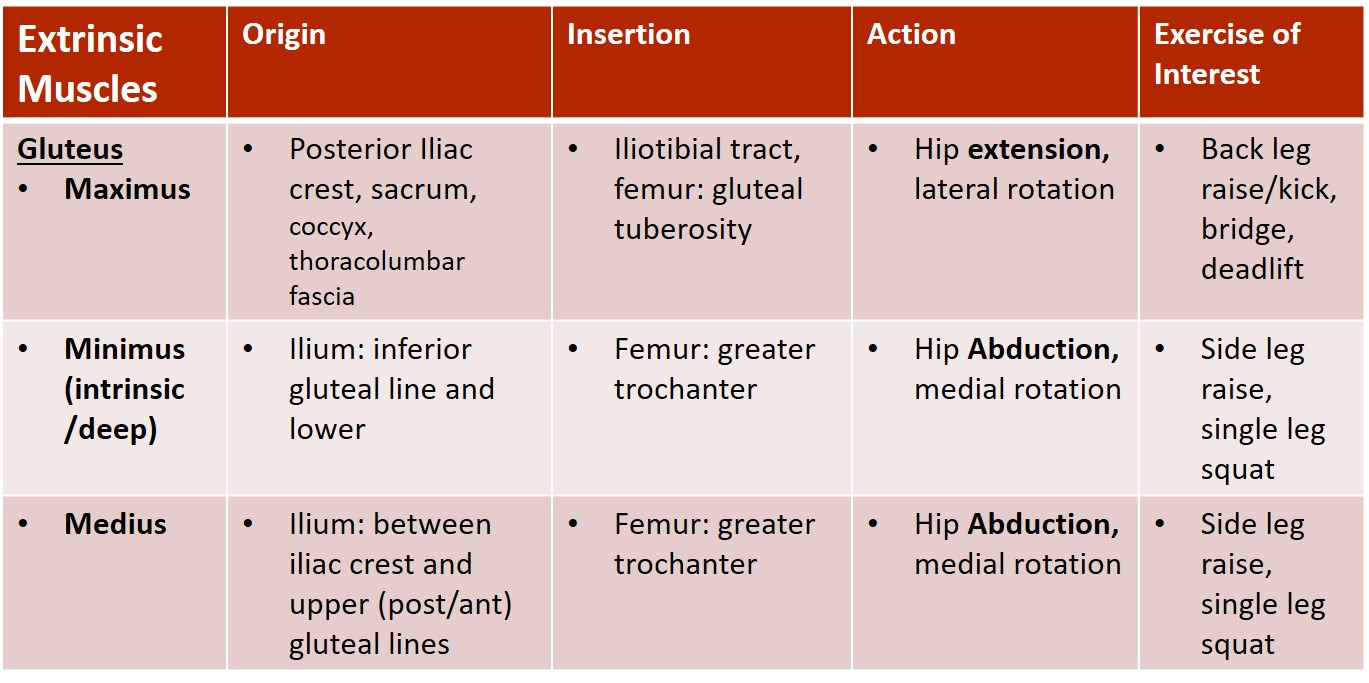
TFL Muscle
Discuss the O, I, and A of the following core muscles.
Tensor Fascia Latae (TFL)
Iliotibial Band (ITB)
Which two muscles insert into the ITB?
Which muscle is directly beneath the ITB?

Posterior Knee and Pelvis
Pelvis
Discuss the key features of the posterior pelvis as it relates to the hamstring and gluteal muscles (i.e. Iliac crest, PSIS, PIIS, Gluteal Lines (Posterior, Anterior and Inferior), Greater Sciatic Notch, Ischium, Ischial Tuberosity, and Ischial Spine.

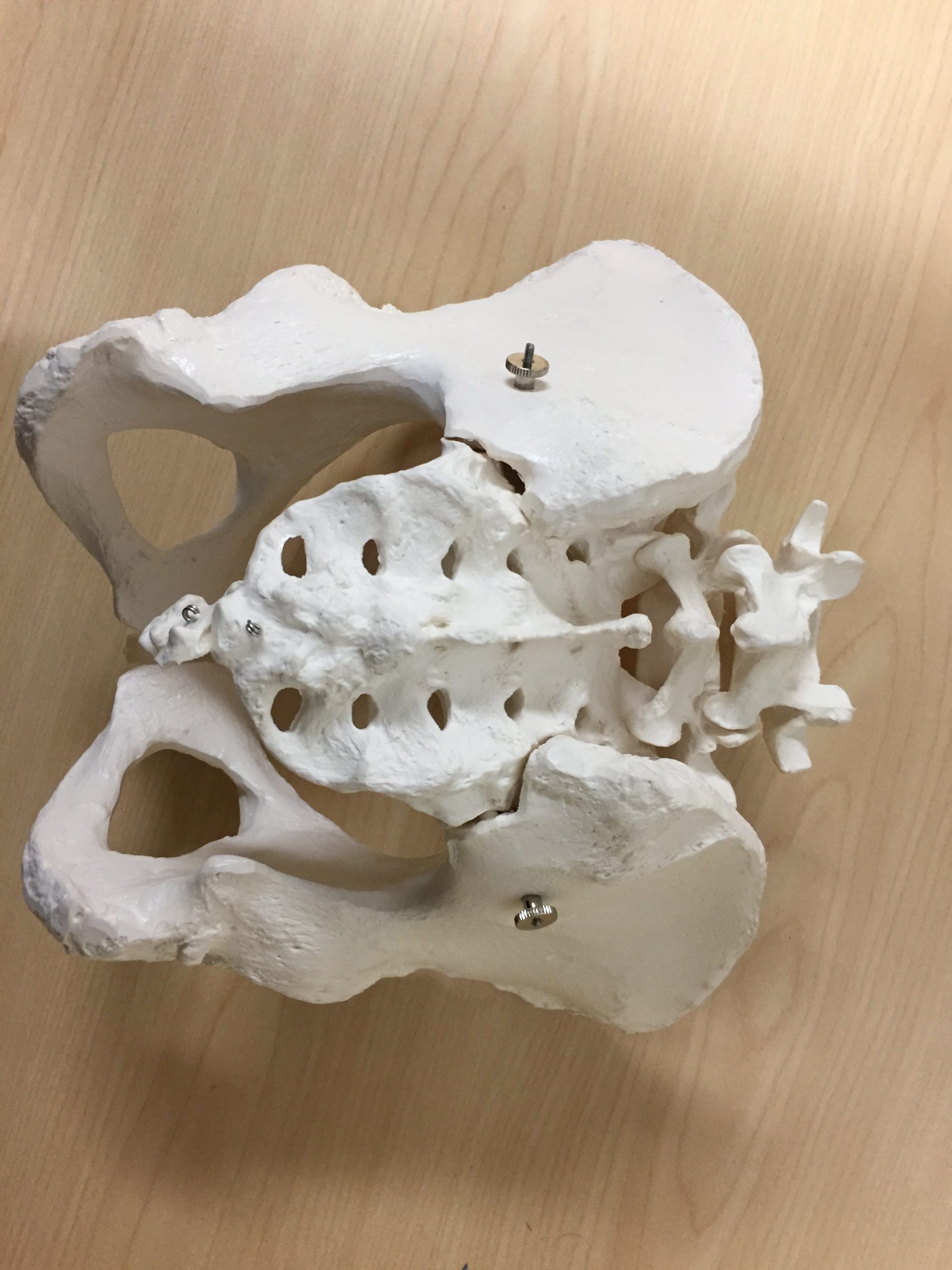
Knee
Discuss the key features of the posterior pelvis as it relates to the hamstring muscles (i.e. Fibular head, Medial and lateral condyles of the Tibia).
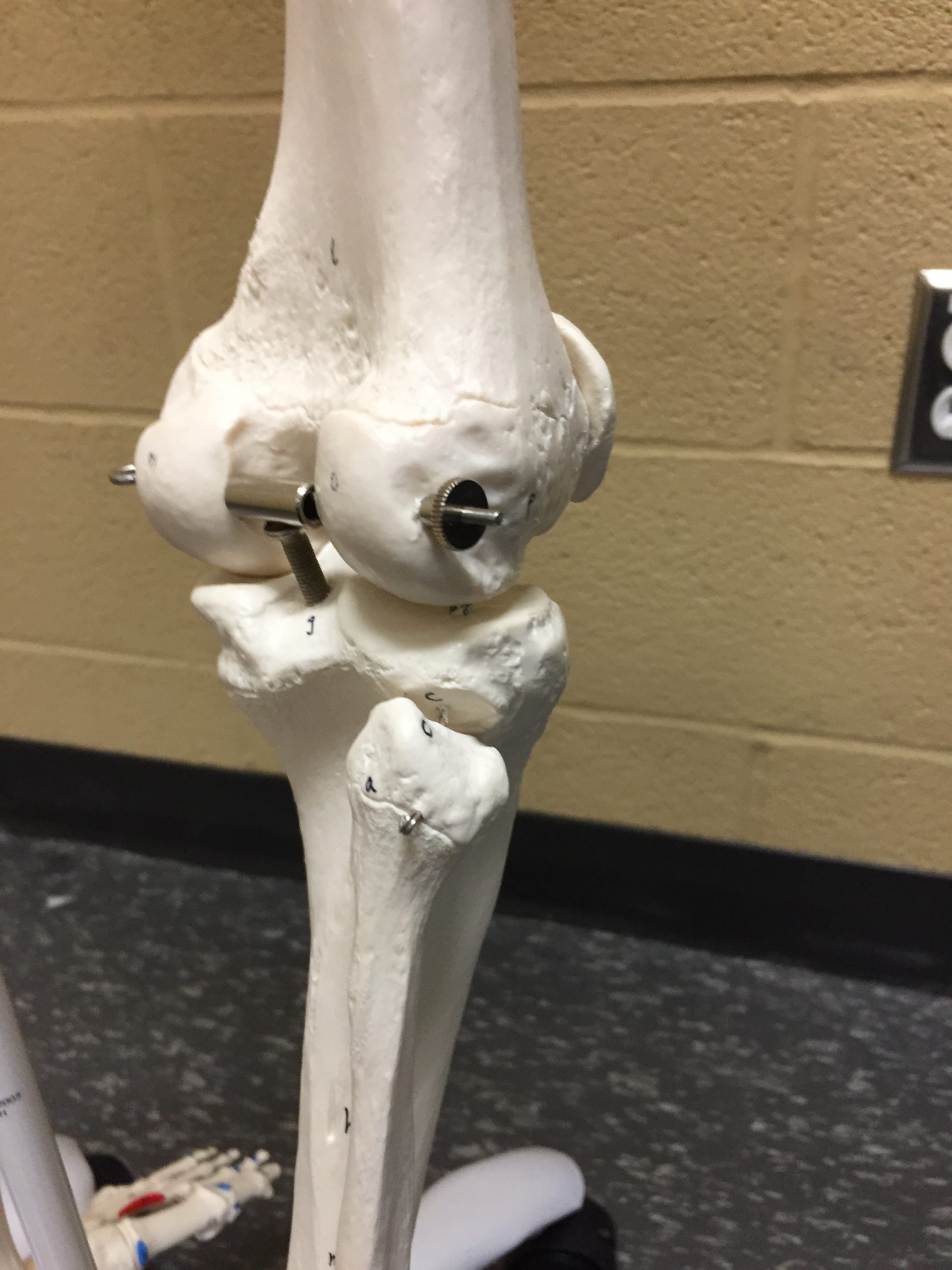
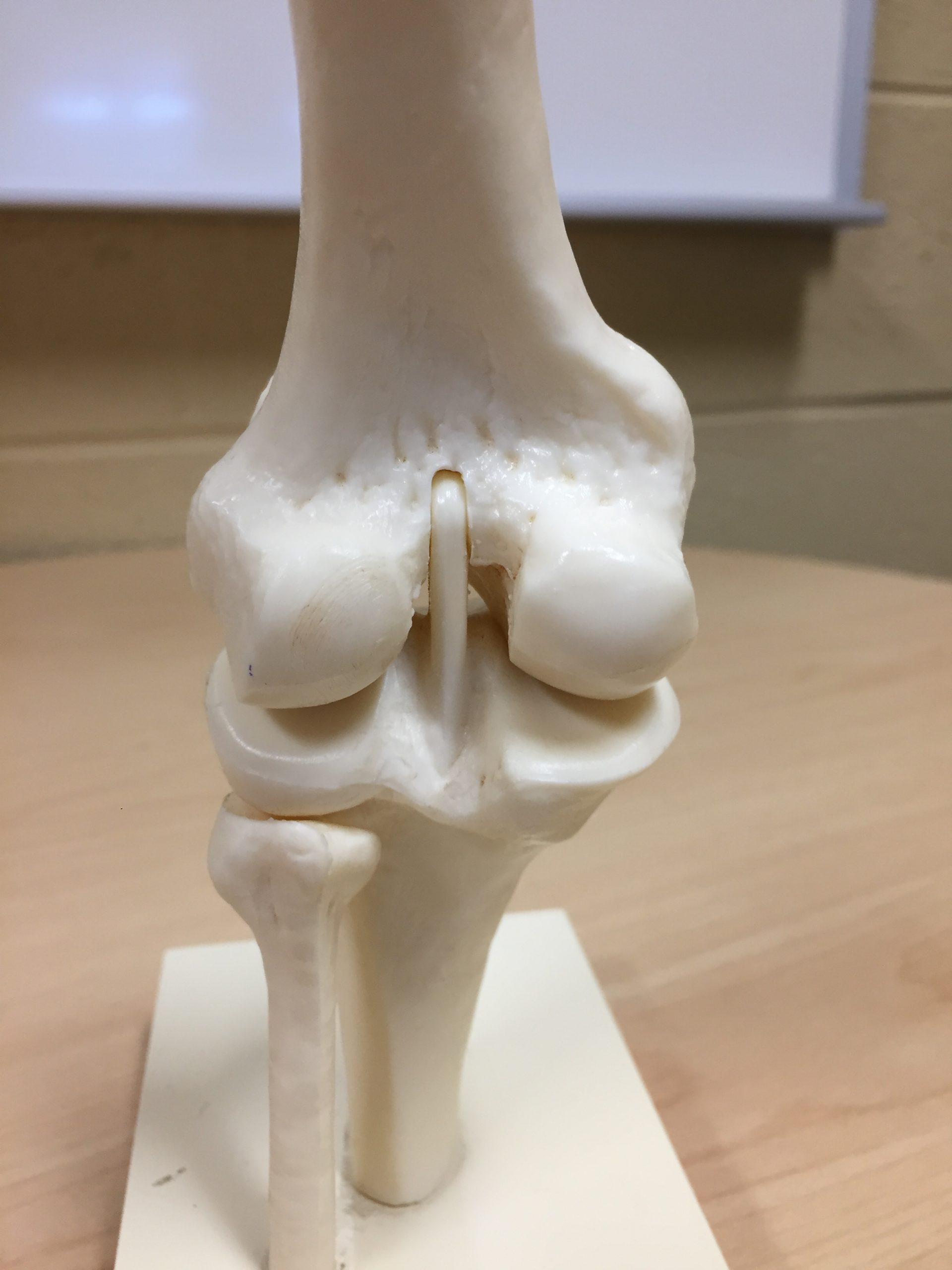
Hamstrings Muscle
Key Bony Markings
Discuss the key bony markings related to the hamstring muscle (posterior pelvis, ischium, ischial tuberosity, PSIS, PIIS), femur (linea aspera, gluteal tuberosity, femoral condyles), tibial condyles and fibular head.


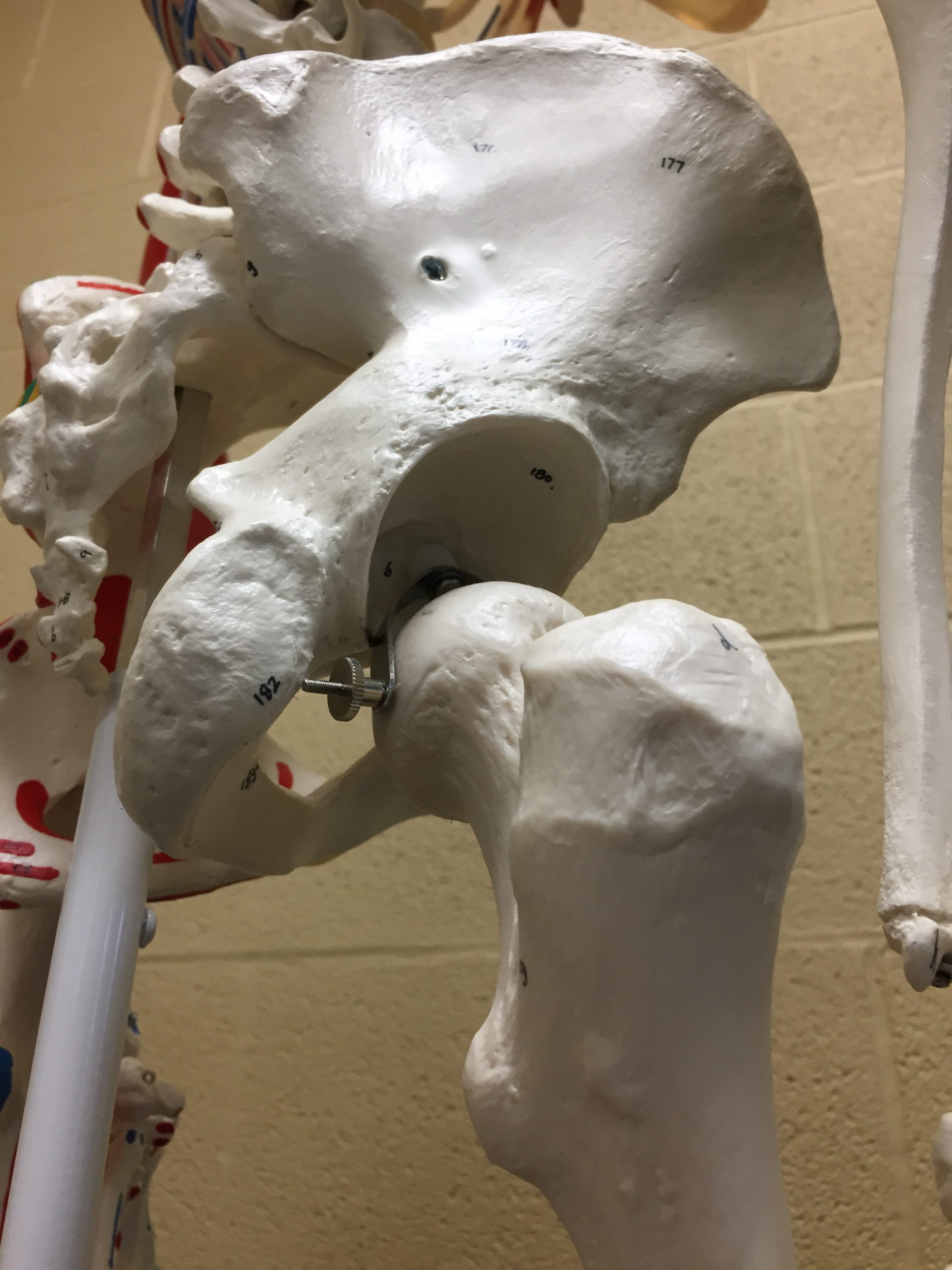
The Hamstrings
Discuss the O, I, and A of the following muscles.
- Biceps Femoris
- Semitendinosus
- Semimembranosus
